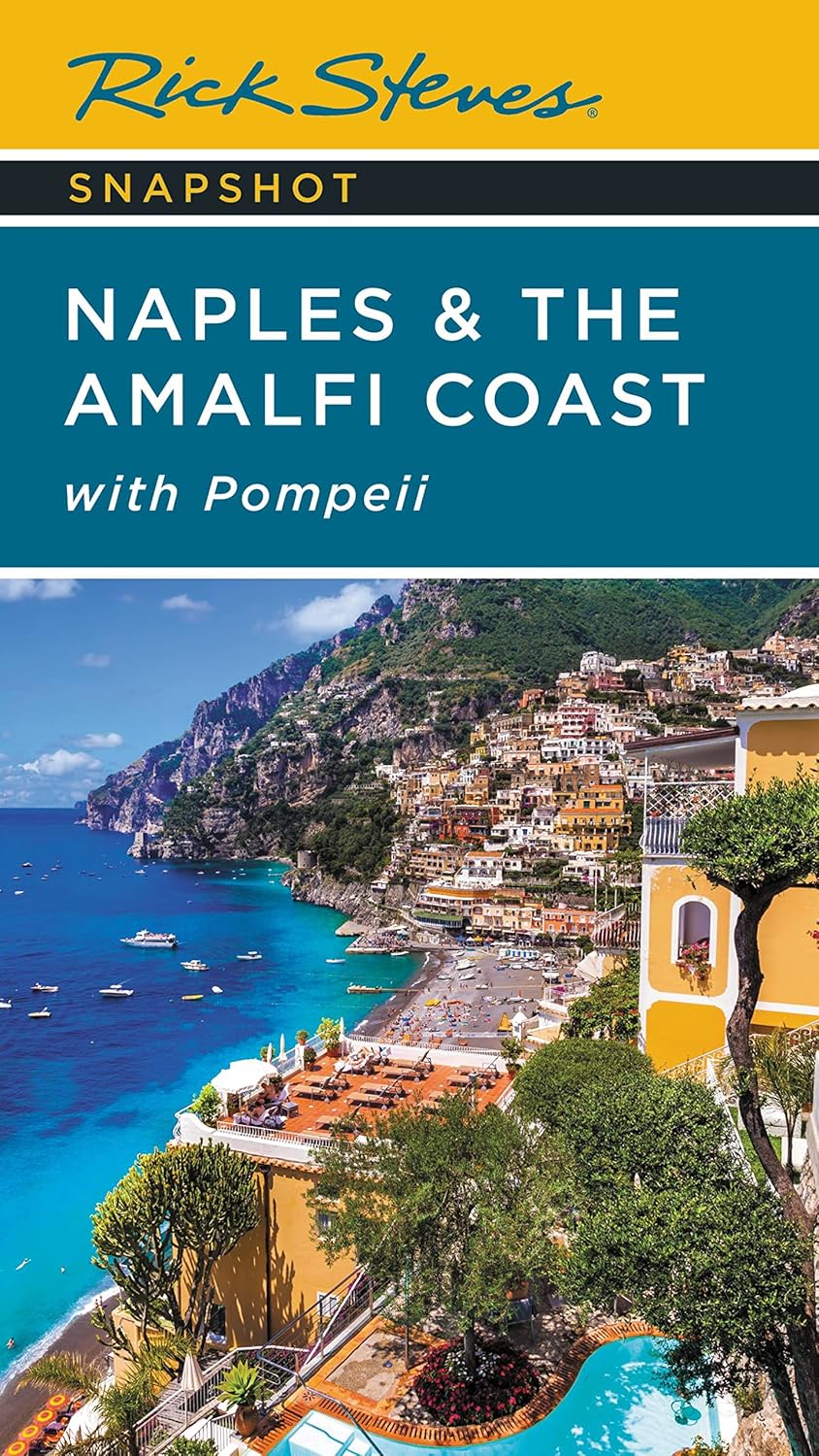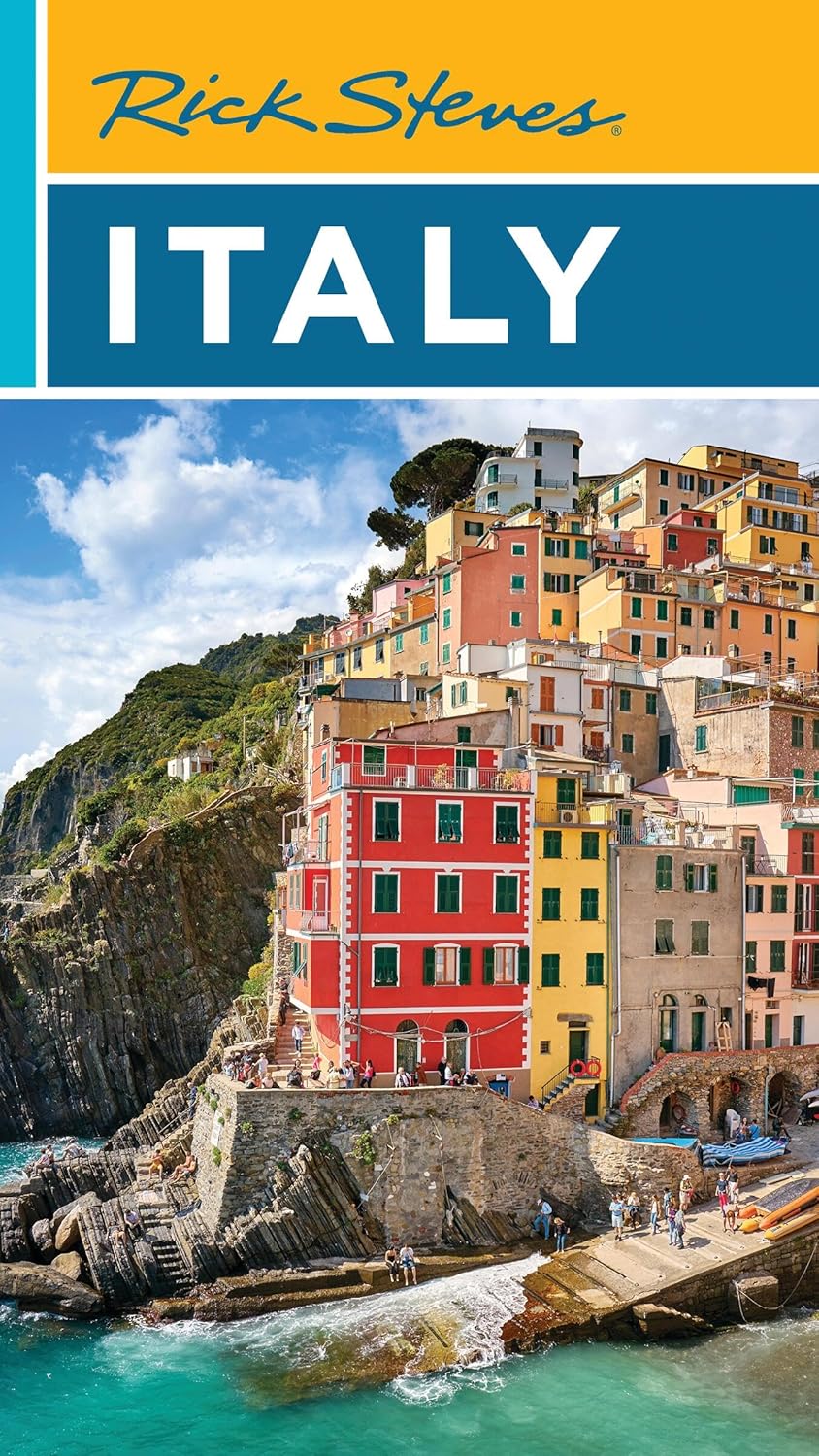The Amalfi Coast Of Italy
The Amalfi coast of Italy.
Picture yourself winding along dramatic cliffs where azure waters meet ancient villages that seem to defy gravity itself. The Amalfi coast of Italy represents one of the world's most breathtaking stretches of coastline, where every turn reveals postcard-perfect vistas that have captivated travelers for centuries.
This UNESCO World Heritage site stretches for about 50 kilometers along the southern edge of Italy's Sorrentine Peninsula, offering an intoxicating blend of natural beauty, rich history, and Mediterranean charm that will leave you planning your return visit before you've even left.
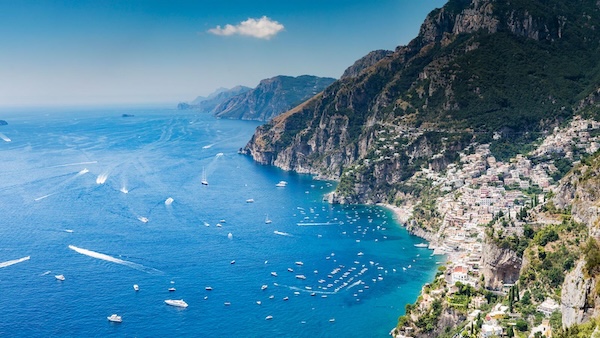 The Amalfi coast
The Amalfi coast
What Is The Amalfi Coast Of Italy?
What is the Amalfi coast? It's a magical ribbon of coastline in the Campania region of southern Italy, carved into the rugged cliffs of the Lattari Mountains. This stunning stretch runs from the town of Vietri sul Mare in the east to Positano in the west, encompassing thirteen municipalities that each offer their own unique character and attractions.
The coast is famous for its dramatic vertical landscape, where colorful houses cascade down steep hillsides like a watercolor painting come to life, creating some of the most photographed scenery in all of Europe.
Where is the Amalfi coast?
Where is the Amalfi coast? Located in the province of Salerno in southern Italy, this coastal paradise sits about 50 kilometers south of Naples and roughly 40 kilometers from the ancient ruins of Pompeii. The region is positioned on the Tyrrhenian Sea, offering spectacular views across the water toward the island of Capri.
The coast's strategic location has made it a crossroads of Mediterranean cultures for over a thousand years, contributing to its rich tapestry of architectural styles, culinary traditions, and artistic heritage that visitors can still experience today.
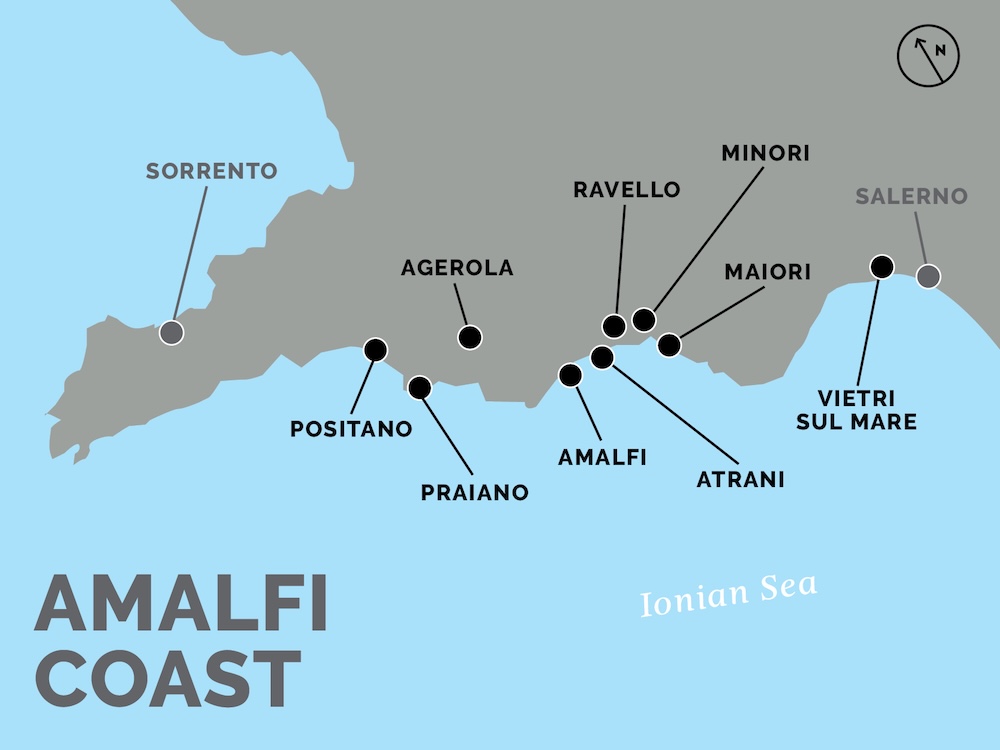 Map of the Amalfi coast
Map of the Amalfi coastGetting to the Amalfi coast requires some planning, but the journey is part of the adventure. The nearest major airport is Naples International Airport, about 60 kilometers away, where you can rent a car or take the Curreri shuttle bus directly to various coastal towns. Many travelers prefer to fly into Rome's airports and take the high-speed train to Naples, then continue by bus or private transfer.
If you're feeling adventurous, consider taking the ferry from Naples or Sorrento during the warmer months – the approach by sea offers an unforgettable first glimpse of the coast's dramatic beauty.
The famous Amalfi Drive, or Strada Statale 163, is the main artery connecting all the coastal towns, but don't underestimate this winding mountain road. This narrow, serpentine route carved into the cliffs can be both exhilarating and nerve-wracking, especially during peak season when tour buses and cars compete for space.
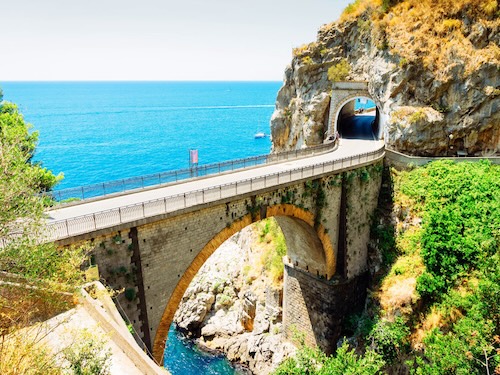 Part of the SS163
Part of the SS163Local buses run regularly between towns and offer a stress-free alternative to driving yourself, plus you'll get to enjoy the scenery without worrying about navigating hairpin turns while other drivers honk impatiently behind you.
Positano stands as perhaps the most iconic destination along the Amalfi coast, and for good reason. This vertical village tumbles down the mountainside in a cascade of pastel-colored houses, boutique hotels, and lemon groves that create an almost fairy-tale atmosphere.
The town's main beach, Spiaggia Grande, offers excellent swimming and people-watching opportunities, while the narrow streets above hide charming shops selling handmade sandals, locally-produced limoncello, and beautiful ceramics that make perfect souvenirs of your visit.
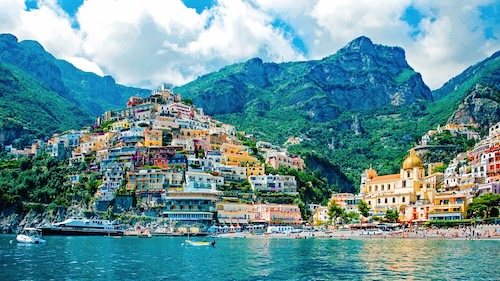 A view of Positano from the sea
A view of Positano from the seaWhat makes Positano truly special is its sophisticated yet relaxed atmosphere that attracts celebrities, artists, and discerning travelers from around the world. The town's restaurants serve exceptional seafood caught fresh from local waters, and many establishments offer terraces with panoramic views that make every meal feel like a special occasion.
Don't miss climbing up to the Chiesa di Santa Maria Assunta with its distinctive majolica-tiled dome, or taking the scenic path to the smaller, more secluded Fornillo Beach for a quieter swimming experience.
The Amalfi Coast Of Italy
Amalfi town, the coast's namesake town, holds the distinction of being a former maritime republic that once rivaled Venice, Genoa, and Pisa in power and influence. Today, this historic town centers around its magnificent cathedral, the Duomo di Amalfi, whose Arab-Norman architecture and striking facade reflect the town's cosmopolitan past.
The cathedral's bronze doors, cast in Constantinople, and its beautiful cloister filled with ancient columns and peaceful gardens, provide a fascinating glimpse into the region's rich medieval heritage.
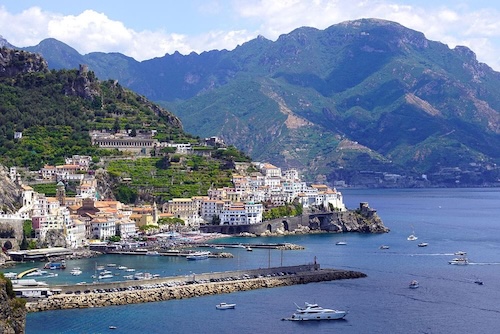 An aerial view of Amalfi town
An aerial view of Amalfi townThe town of Amalfi offers excellent shopping opportunities, particularly for the region's famous handmade paper, which has been produced here since the 13th century. Visit the Museo della Carta (Paper Museum) to see traditional papermaking techniques in action, then browse the local shops for beautiful stationery, journals, and artistic prints.
The town's main square, Piazza del Duomo, comes alive in the evenings when locals gather for their traditional passeggiata, creating a wonderful opportunity to experience authentic Italian social culture.
Ravello, perched high above the coast at 365 meters above sea level, offers some of the most spectacular panoramic views in all of Italy. This refined hilltop town has long attracted artists, writers, and musicians, including Richard Wagner, who found inspiration here for his opera Parsifal.
The town's two main attractions, Villa Rufolo and Villa Cimbrone, feature stunning gardens that seem to float above the Mediterranean, creating perfect settings for the town's famous summer music festival that draws classical music lovers from around the world.
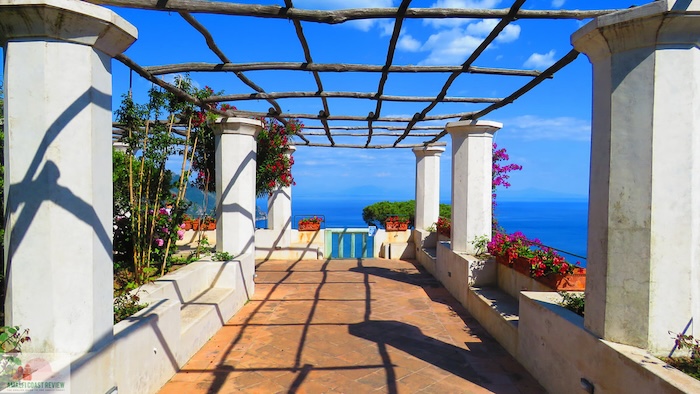 Villa Rufolo
Villa RufoloVilla Rufolo's gardens, with their exotic plants and Moorish-influenced architecture, provide the backdrop for Ravello's annual Wagner Festival, where world-class musicians perform against one of the most beautiful natural amphitheaters imaginable.
Villa Cimbrone's "Terrace of Infinity" offers what many consider the finest view on the entire coast, stretching across the Gulf of Salerno to the distant mountains of Calabria. These elevated perspectives give you a completely different appreciation for the coast's dramatic geography and natural beauty.
Amalfi Coast Day Trip from Sorrento: Positano, Amalfi, and Ravello
Spend a day discovering the towns of the Amalfi Coast with this group tour from Sorrento. The UNESCO-listed stretch of coastline is believed to be Italy’s most beautiful, but exploring it on your own can be tricky. Let someone else navigate the roads as you admire the scenery and listen to commentary about the region. Then stop for visits in the towns of Positano, Amalfi, and Ravello, exploring each one at your leisure.
- Avoid the hassle of logistics, driving, and parking
- Admire the scenery of the UNESCO-listed coast as you travel
- Stop to explore Positano, Amalfi, and Ravello on your own
- Hear fun facts and stories about the coastal region along the way
Read more and book this tour with our trusted partner Viator - Amalfi Coast Day Trip from Sorrento: Positano, Amalfi, and Ravello
Atrani, often overlooked by tourists rushing between the larger towns, represents one of Italy's smallest municipalities and offers an authentic glimpse of traditional coastal life. This tiny fishing village, with its narrow alleys and small piazzas, feels like a secret hideaway where time has stood still.
The town's beach provides a peaceful alternative to the busier stretches of sand, and its restaurants serve some of the coast's best seafood at prices that won't shock your wallet like those in more famous destinations.
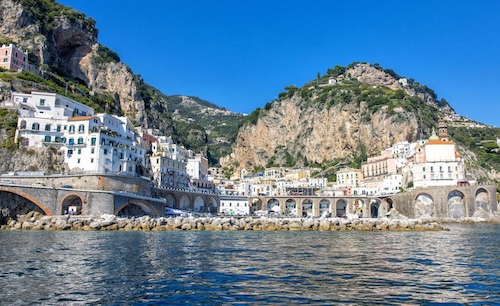 Atrani
AtraniThe Amalfi Coast Of Italy
Furore, known as the "town that doesn't exist" because its houses are scattered across the mountainside rather than clustered together, offers one of the coast's most dramatic sights at the Fiordo di Furore.
This deep gorge cuts through the cliffs to create a small pebble beach accessible by a steep path, where crystal-clear waters and towering rock walls create an almost mystical atmosphere. Each summer, the gorge hosts an international high-diving competition that transforms this quiet spot into a spectacular sporting venue.
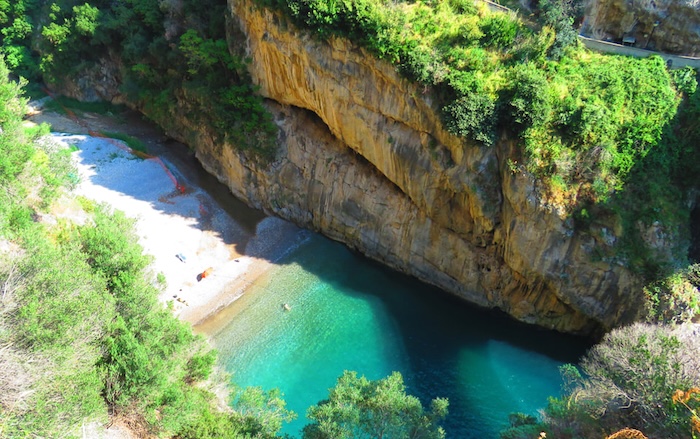 The Fiordo di Furore
The Fiordo di FuroreCetara, a working fishing village at the eastern end of the coast, specializes in anchovy fishing and processing, continuing traditions that date back centuries. This authentic town offers visitors the chance to taste some of Italy's finest anchovy-based products, including the prized colatura di alici, a fish sauce that rivals the best Asian varieties in complexity and flavor.
The town's restaurants serve exceptional seafood dishes that showcase these local specialties, often at more reasonable prices than you'll find in the more touristy destinations.
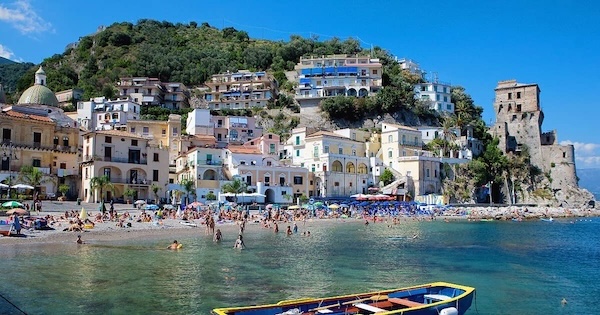 Cetara
CetaraMaiori boasts the coast's longest sandy beach, making it particularly popular with families and travelers seeking more space to relax by the sea. This town suffered significant damage during World War II but has been beautifully rebuilt, combining modern amenities with traditional coastal charm.
The town's seafront promenade offers excellent restaurants and cafes, while the surrounding hills hide ancient watchtowers and hiking trails that provide spectacular views without the crowds found at more famous viewpoints.
 Maiori Beach on the Amalfi coast
Maiori Beach on the Amalfi coastMinori, Maiori's smaller neighbor, charms visitors with its lemon groves and the remains of a Roman villa that demonstrate the area's long history as a retreat for wealthy Romans. The town's pastry shops produce some of the coast's finest sweets, including the famous delizia al limone, a lemon-flavored dessert.
The town's compact size makes it perfect for a leisurely stroll, and its restaurants offer excellent value compared to the more famous destinations nearby.
A Handy Guidebook to explore Naples & the Amalfi Coast
With selective coverage and Rick's trusted insight into the best things to do and see, Rick Steves Snapshot Naples & the Amalfi Coast is truly a tour guide in your pocket.
Rick's firsthand, up-to-date advice on the Amalfi Coast's best sights, restaurants, hotels, and more, plus tips to beat the crowds, skip the lines and Top sights and local experiences. Includes helpful maps and self-guided walking tours.
Read more and purchase this great guidebook here!
The Amalfi Coast Of Italy
Conca dei Marini, one of the coast's smallest towns, hides the famous Emerald Grotto (Grotta dello Smeraldo), an underwater cave where sunlight filtering through a submerged opening creates an ethereal emerald glow.
This natural wonder, accessible by boat or elevator from the coastal road, contains stalactites and stalagmites formed over thousands of years, plus an underwater nativity scene that adds a touch of whimsy to this geological marvel. The town itself offers peaceful beaches and excellent seafood restaurants away from the crowds.
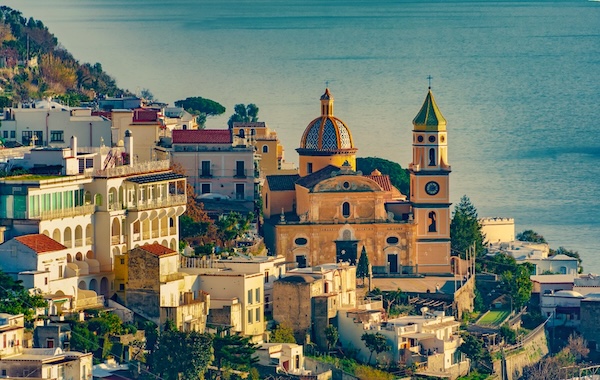 Conca dei Marini
Conca dei MariniPraiano, stretching along the coast between Positano and Amalfi, offers a more relaxed alternative to its famous neighbors while still providing stunning views and excellent amenities. The town's Marina di Praia features a small beach surrounded by colorful houses and good restaurants, while the upper town provides hiking opportunities and spectacular sunset views.
This location makes an excellent base for exploring the entire coast, with good transportation connections and a more authentic, less touristy atmosphere than some other destinations.
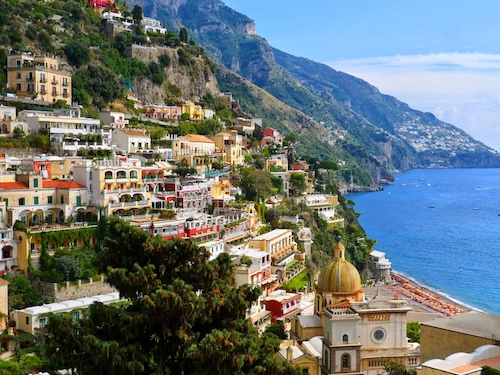 Praiano
PraianoThe best time to visit the Amalfi coast requires careful consideration of weather, crowds, and local conditions. The peak season from June through August brings perfect weather and long days, but also massive crowds, inflated prices, and traffic jams that can turn the scenic coastal drive into a frustrating crawl.
Recent over-tourism has made these summer months particularly challenging, with some towns implementing visitor limits and restricted access during the busiest periods to preserve both the environment and the quality of life for residents.
For the most enjoyable experience, consider visiting during the shoulder seasons of late April through May or September through early October. During these periods, you'll enjoy pleasant weather perfect for hiking and swimming, while avoiding the worst crowds and highest prices of peak season.
The spring months offer the added bonus of wildflowers blooming across the hillsides and comfortable temperatures for exploring, while early fall provides warm sea temperatures ideal for swimming and clear skies perfect for photography.
The Amalfi Coast Of Italy
Winter visits, while less popular, offer their own unique rewards for travelers seeking a more intimate experience of the coast. Many hotels and restaurants close from November through March, but those that remain open provide excellent value and personalized service.
The weather can be unpredictable, with occasional storms creating dramatic seascapes, but clear winter days offer crystal-clear visibility and snow-capped mountains in the distance that create unforgettable photographic opportunities.
Top Tip: the best views often come from hiking the ancient paths that connect the coastal towns. The Path of the Gods (Sentiero degli Dei) between Bomerano and Nocelle offers spectacular panoramas without the crowds found at the famous roadside viewpoints.
Start early in the morning to avoid both heat and crowds, and consider hiring a local guide who can share stories about the area's history and point out hidden details you might otherwise miss.
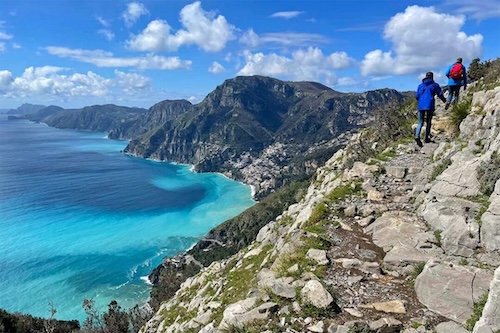 Path of the Gods/Sentiero degli Dei
Path of the Gods/Sentiero degli DeiLocal residents recommend avoiding the coastal road during peak hours (10 AM to 4 PM) in summer, when traffic moves at a crawl and parking becomes nearly impossible. Instead, use these hours for activities away from the main tourist areas:
- visit local markets in the early morning,
- take a boat trip to explore hidden coves,
- or retreat to higher elevations where temperatures are cooler and views are even more spectacular.
Many locals do their shopping and errands in the early morning or late evening, when the towns return to a more authentic, relaxed pace.
The coast's famous lemons, particularly the large sfusato amalfitano variety, grow in terraced groves that you can visit through local agritourism experiences. These family-run operations offer tastings of limoncello, lemon marmalade, and other citrus products while explaining the traditional cultivation methods that have shaped the landscape for centuries.
Many of these experiences include cooking classes where you'll learn to prepare traditional dishes using local ingredients, creating memories and skills that will last long after your vacation ends.
For the best dining experiences, look for restaurants where locals eat rather than those with the most prominent tourist locations. Small family-run trattorias in the upper parts of towns often serve superior food at better prices than waterfront establishments that rely primarily on tourist traffic.
Ask your hotel concierge or local shopkeepers for recommendations, and don't be afraid to venture into neighborhoods away from the main tourist areas where authentic flavors and genuine hospitality await.
The Amalfi Coast Of Italy
Transportation along the coast requires patience and planning, especially during busy periods. The SITA buses that connect all the major towns run frequently but can become extremely crowded during peak season.
Purchase tickets in advance from tobacco shops or bars, and be prepared to wait for multiple buses during busy times. Many locals recommend using the ferry services between towns when available, as they offer spectacular views and avoid traffic congestion entirely.
Accommodation booking requires advance planning, particularly for visits during peak season or special events. Many of the coast's most charming hotels are small, family-run properties with limited rooms that fill up months in advance.
Consider staying in less famous towns like Cetara or Atrani, where you'll find better value and more authentic experiences while still having easy access to the major attractions. Vacation rentals can offer excellent value for longer stays, especially for families or groups traveling together.
The coast's hiking opportunities extend far beyond the famous Path of the Gods, with numerous trails connecting ancient villages, abandoned monasteries, and hidden viewpoints. The Valle delle Ferriere near Amalfi offers a completely different landscape of waterfalls and lush vegetation.
The trail from Ravello to Minori passes through lemon groves and offers spectacular coastal views. Always carry water, wear appropriate footwear, and check weather conditions before setting out on any hiking adventure.
Photography enthusiasts should plan their shots carefully to avoid the harsh midday light that washes out the coast's beautiful colors. The golden hours just after sunrise and before sunset provide the most flattering light for the pastel houses and dramatic landscapes.
Many of the best viewpoints require short hikes or climbs, so bring appropriate equipment and be prepared to work for the perfect shot. Local photography workshops can provide insider knowledge about the best locations and optimal timing for different subjects.
Cultural experiences abound throughout the coast, from traditional ceramic workshops in Vietri sul Mare to ancient paper mills in Amalfi. Many towns host seasonal festivals celebrating local patron saints, harvest seasons, or historical events that provide authentic glimpses into local traditions.
The Regata Storica delle Antiche Repubbliche Marinare, held every four years in Amalfi, recreates the town's maritime glory with historical costumes and traditional boats that bring the past to life.
Swimming and beach activities vary significantly from town to town, with some offering sandy beaches while others feature pebbles or rocky coastlines. The water quality along the coast is generally excellent, but be aware that many beaches are quite small and can become extremely crowded during peak season.
Consider renting a boat to explore hidden coves and swimming spots accessible only from the water, or visit the beaches early in the morning or late in the afternoon when they're less crowded.
Shopping opportunities range from high-end boutiques in Positano to traditional craft workshops throughout the region. Look for locally-made products like handcrafted sandals, ceramic pottery, and artisanal food products that reflect the area's cultural heritage.
Many shops offer shipping services for larger purchases, and don't forget to ask about tax-free shopping if you're visiting from outside the European Union. The best deals often come from shopping directly with artisans in their workshops rather than in tourist-focused retail stores.
Here is an aerial drone video of the Amalfi coast:
Your visit to the Amalfi coast of Italy will create memories that last a lifetime, but success requires thoughtful planning and realistic expectations. Embrace the slower pace of life, savor the incredible food and wine, and take time to appreciate the natural beauty that has inspired visitors for centuries.
Whether you spend your days hiking ancient paths, lounging on picturesque beaches, or exploring historic towns, the coast's magic lies not just in its stunning scenery but in its ability to help you slow down and appreciate life's simple pleasures. Plan ahead, travel during shoulder seasons if possible, and prepare to fall in love with one of the world's most beautiful coastlines.

